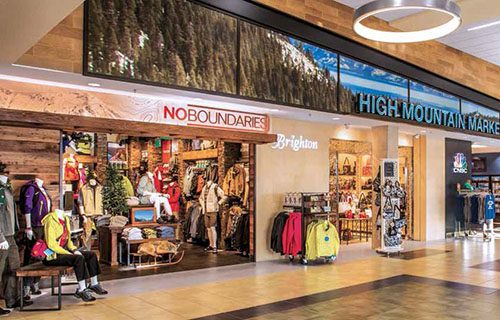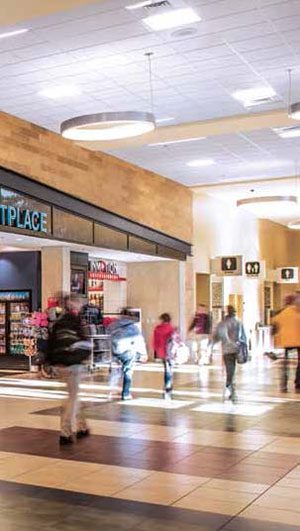Officials at Reno-Tahoe International Airport (RNO) are wearing smiles these days. They're happy because the airport's Gateway Project, a $29 million terminal renovation initiative, is open to the flying public and Reno community – a month ahead of schedule.

|
factsfigures Project: Terminal Expansion & Renovation Location: Reno-Tahoe Int'l Airport Key Elements: Security checkpoint consolidation; baggage claim renovation/redesign; relocation of concessions Cost: $29.3 million Funding: $11.5 million passenger facility charges; $16.3 million subordinate revenue notes; $1.5 million misc. sources Grand Opening: March 2013 Owner's Representative/Program Manager: Atkins North America Architect of Record: Gresham, Smith and Partners General Contractor: Q & D Construction HVAC: Fleet Heating & Air; J.W. McClenahan Co. Plumbing: RHP Mechanical Systems Electrical: Nelson Electric Co. Electrical Consultant: PK Electrical Structural Steel: Reno Iron Works Co. Mechanical Engineering Consultant: Petty & Associates Civil Engineering Consultant: Wood Rodgers Low Voltage Contractor: RFI Communications & Security Systems Food & Beverage Mgm't: SSP Retail Operations: The Paradies Shops Of Note: Recent renovations were the last of three major airport improvement projects totaling $100 million |
The Gateway Project is the last of three back-to-back improvement projects totaling nearly $100 million. The first began in 2008 and included a $63 million check-in area, infrastructure improvements and a new inline baggage system. It was followed by a $6.5 million baggage claim redesign to match the look and feel of the new check-in area.
The Gateway Project, which began in November 2011, tops off the previous infrastructure and facilities improvements with a new security checkpoint, new concessions and a 40-foot terminal bump-out. The new square footage features a restaurant that overlooks the tarmac and the mountains beyond RNO.
In designing the renovations, airport officials sought to include "everything that is special and good about northern Nevada," explains President/Chief Executive Officer Krys Bart.
"From Security to our restaurants and stores, the entire look and feel of the airport reflects our community and region," adds Brian Kulpin, the airport's vice president of marketing and public affairs. "It's taken our airport to a whole new level in terms of welcoming and sending travelers off in the Reno-Tahoe region."
9/11 Changed Everything
Bart summarizes the impetus behind the renovations in one word: security.
RNO's original terminal was built in 1960, just in time for the Squaw Valley Olympics, with two security checkpoints – one in each of its two concourses. With the introduction of new post-9/11 security technologies, the airport found itself in a real estate crunch.
"It was clear," Bart recalls. "We couldn't fit the AITs (advanced imaging technology) into our checkpoint configuration. We wanted the AITs because they are much more customer service oriented, particularly for the elderly or those with special needs. But we just didn't have the space – no queuing space, no post-security space to put your shoes back on. It was extremely constrained."
Airport officials initially delayed installing new security equipment to focus on expanding the checkpoint areas; but they soon concluded that expanding the checkpoint areas was not feasible. The ultimate solution, consolidating the two checkpoints into a single checkpoint, required expanding the entire terminal.
It was a "knee-bone-connected-to-the-thigh-bone" kind of problem: To create security checkpoint space, RNO had to free up space in the first-floor food court area. That, in turn, created the need for a new home for food concessions.
Phase 2 of the project, which began in April 2012, combined the airport's previous two security checkpoints on the second floor into a central checkpoint on the first floor. The new checkpoint, which can screen more than 1,300 people per hour, includes seven lanes, three AITs and more space for travelers.
Q & D Construction navigated the challenges of keeping the airport operational while gutting the middle of the terminal, building it out 40 feet and raising the roof 16 to 18 feet. "It was very complex dealing with two or three generations of construction work dating back to the 1960s," notes Tim Kretzschmar, senior vice president of Q & D Construction's Building Division.
The results, however, are proving very popular. "We had a security-driven-need that has ended up as an amazing customer service and retail opportunity for the airport," says Kulpin.
Phase 1
While security changes drove RNO's infrastructure improvements, construction began with installation of a new inline baggage system and Baggage Claim renovations in December 2011.
Crews removed carpet, reconstructed columns and installed new terrazzo flooring. To maintain baggage operations during the renovations, contractors completed work in phases behind construction walls throughout the first floor. Extensive signage directed passengers throughout the baggage claim area.
From the beginning of the Gateway Project, airport officials worked to infuse the look and feel of the Reno-Tahoe region throughout the terminal.
"We brought in wood and stone native to the region," reports Sean Bogart, project manager for architect of record Gresham, Smith & Partners. "Those design elements were extended throughout the first level as well as into the security checkpoint and concessions area on the second level."
 Bart and other airport executives are enthusiastic about the terminal's new earth tone color palette, noting that is indicative of the nearby mountains. Terrazzo tile, suggestive of the Truckee River and the endangered lahontan cutthroat trout, snakes through the Baggage Claim area. Columns feature native rock, and lighting fixtures suggest the chalets and lodges prominent in the Tahoe area. A 10-foot sculpture of a skier serves as the airport's icon.
Bart and other airport executives are enthusiastic about the terminal's new earth tone color palette, noting that is indicative of the nearby mountains. Terrazzo tile, suggestive of the Truckee River and the endangered lahontan cutthroat trout, snakes through the Baggage Claim area. Columns feature native rock, and lighting fixtures suggest the chalets and lodges prominent in the Tahoe area. A 10-foot sculpture of a skier serves as the airport's icon.
"Creating a sense of place was very important for us," Bart explains. "When you land here, you see ski runs from the runways and taxiways. You can literally leave your aircraft and be on a ski slope in an hour. Ponderosa pine, mountain scenery, clear mountain lakes – that's who we are."
To prepare for Phase 2 of the project, the airport opened the Mountain House Diner in April 2012. It provided food and beverage options pre-security on the first floor while the usual food court was closed during construction.
Concessions Overhaul
 Travelers and RNO concessionaires alike have benefited from the airport's multimillion-dollar terminal renovations. Moving retail and food/beverage options behind the new security checkpoint allows travelers to shop and dine leisurely, without worrying about missing their flights because of long lines at Security.
Travelers and RNO concessionaires alike have benefited from the airport's multimillion-dollar terminal renovations. Moving retail and food/beverage options behind the new security checkpoint allows travelers to shop and dine leisurely, without worrying about missing their flights because of long lines at Security.
Travelers are now greeted with food/beverage and retail offerings before moving onto the concourses.
 The Paradies Shops, RNO's retail operations manager, developed a master storefront with a mountain lodge feel. Four retail concepts are included behind the High Mountain Market storefront: No Boundaries, Brighton, CNBC News and InMotion Electronics. PGA Tour Shop and Adventure News are located in the pre-security area.
The Paradies Shops, RNO's retail operations manager, developed a master storefront with a mountain lodge feel. Four retail concepts are included behind the High Mountain Market storefront: No Boundaries, Brighton, CNBC News and InMotion Electronics. PGA Tour Shop and Adventure News are located in the pre-security area.
"We have invested $1.2 million in this new retail presentation and project a 30% increase in gross sales," reports John Calvo, senior director of planning, design and construction for Paradies. "The airport did a great job allocating retail space for the needs of the passengers, and we designed it to match the aesthetic of the overall building, while staying true to the design of the national brand offerings."
The new food court offers a variety of options as travelers exit the new security checkpoint. SSP, which manages RNO's food and beverage operations, included an upscale dining choice with its flagship restaurant, Timber Ridge. Designed around the concept of great lodge dining, it features a circular bar, central fireplace and an 18-foot glass wall that provides customers with uninterrupted views of the tarmac and mountains.
Pat Murray, executive vice president of SSP, is confident that Timber Ridge will "knock everybody's socks off." Murray waxes poetic when describing the lodge-style concept: "It's a snowy day … you've got the expansive view of the mountains, the fireplace, a cocktail or glass of wine from our list of 50 wines."
Murray is optimistic about the revenue potential of Timber Ridge and the other RNO food and beverage concepts. SSP projects gross sales of approximately $12 million during the first full year of operations – nearly double the sales from several years ago.
Creating a Team
From the very beginning of the Gateway Project, airport officials realized that the scope and magnitude of $29 million in renovations would require extensive planning, coordination and communication. To that end, the airport hired Atkins North America as its owner's representative and program manager. It also selected Gresham, Smith and Partners as architect of record, and Q & D Construction as the general contractor.
"Because we knew this was going to be an extremely complex project, we used the construction manager at risk (CMAR) project delivery method," explains RNO's chief operating officer Dean Schultz. "Traditionally, projects such as this have used a design-bid process, whereby the airport hires a design team, which then puts out a package for contractors to bid on. With the CMAR approach, we brought the general contractor in very early in the design process to act as a partner in the development of the design and construction plans."
The CMAR approach was particularly effective as the team faced issues with the airport's 50-year-old  building that couldn't be accounted for by looking at the original plans, explains Schultz. For example, planners had to shore up the terminal's foundations, because they didn't meet current building codes. "The CMAR approach allowed us to address issues and solutions to the construction process as we were designing the project, so we didn't have to react to problems in the field," he relates.
building that couldn't be accounted for by looking at the original plans, explains Schultz. For example, planners had to shore up the terminal's foundations, because they didn't meet current building codes. "The CMAR approach allowed us to address issues and solutions to the construction process as we were designing the project, so we didn't have to react to problems in the field," he relates.
 Linda Shields, program manager with Atkins North America, agrees that the complexity of the project made it well-suited for using the CMAR project delivery method, in that it allowed for full collaboration among the owner, designer and builder.
Linda Shields, program manager with Atkins North America, agrees that the complexity of the project made it well-suited for using the CMAR project delivery method, in that it allowed for full collaboration among the owner, designer and builder.
"(It) enhanced the quality of the work, optimized the schedule and controlled costs," Shields reflects.
Airport management made a concerted effort to engage stakeholders throughout the project – from the airlines to concessionaires. A communication plan was developed early to make sure the community was well-versed in the construction process, notes Kulpin.
The airport's Walk-a-Mile program trained all managers – including the CEO – to circulate throughout the terminal and lobby helping customers navigate the construction. "This was a great program for our entire team, because it reminded us what we are here for – customer service," Kulpin explains.
 In addition to extending the life of its terminal for at least 30 more years, RNO's series of renovation projects also delivered an important ancillary benefit: a boost to the area's recession-racked economy. The Gateway Project alone created jobs for approximately 275 local construction workers.
In addition to extending the life of its terminal for at least 30 more years, RNO's series of renovation projects also delivered an important ancillary benefit: a boost to the area's recession-racked economy. The Gateway Project alone created jobs for approximately 275 local construction workers.
"Our projects have helped keep the region's construction industry afloat," Kulpin proudly states.


